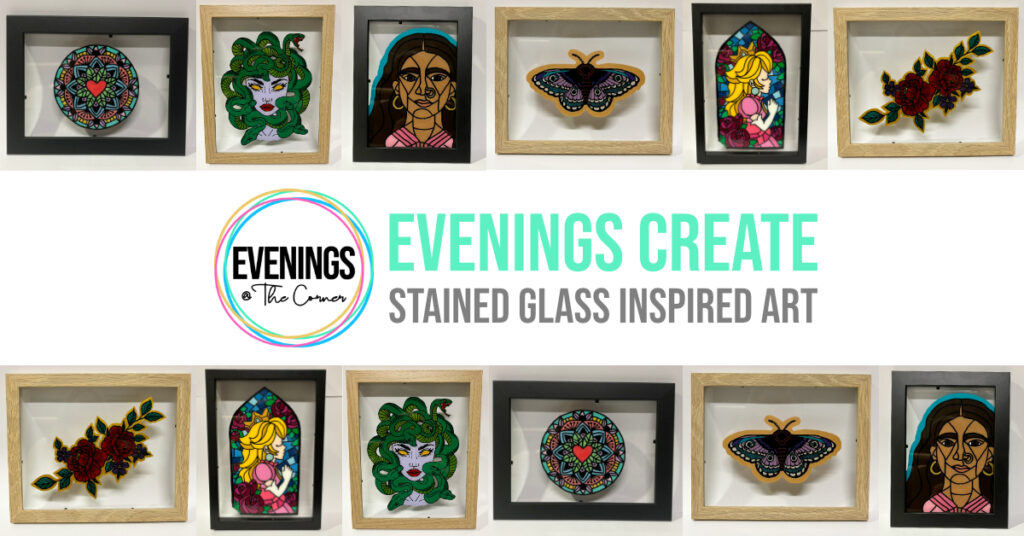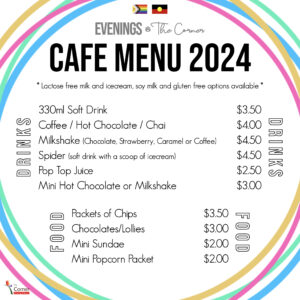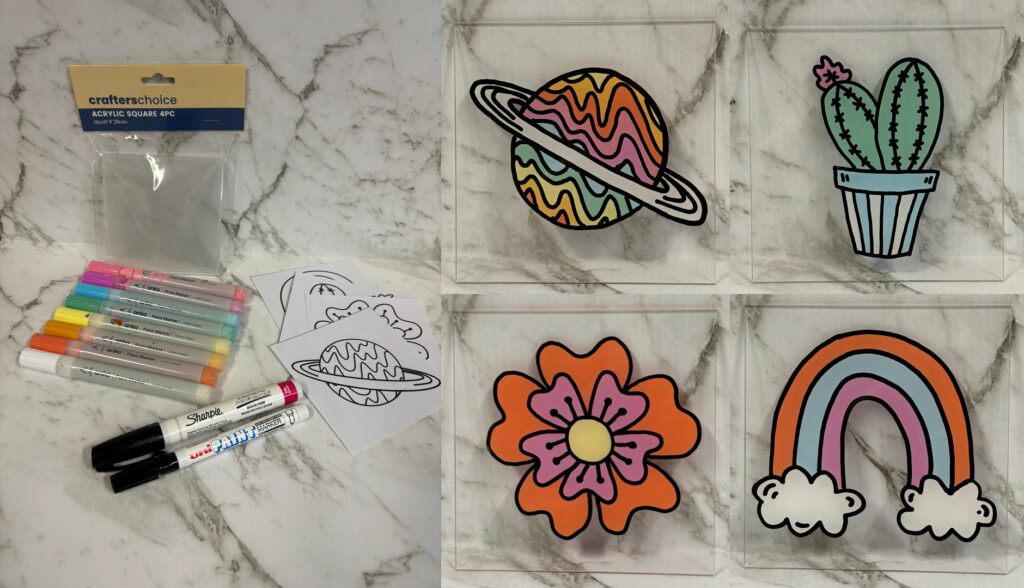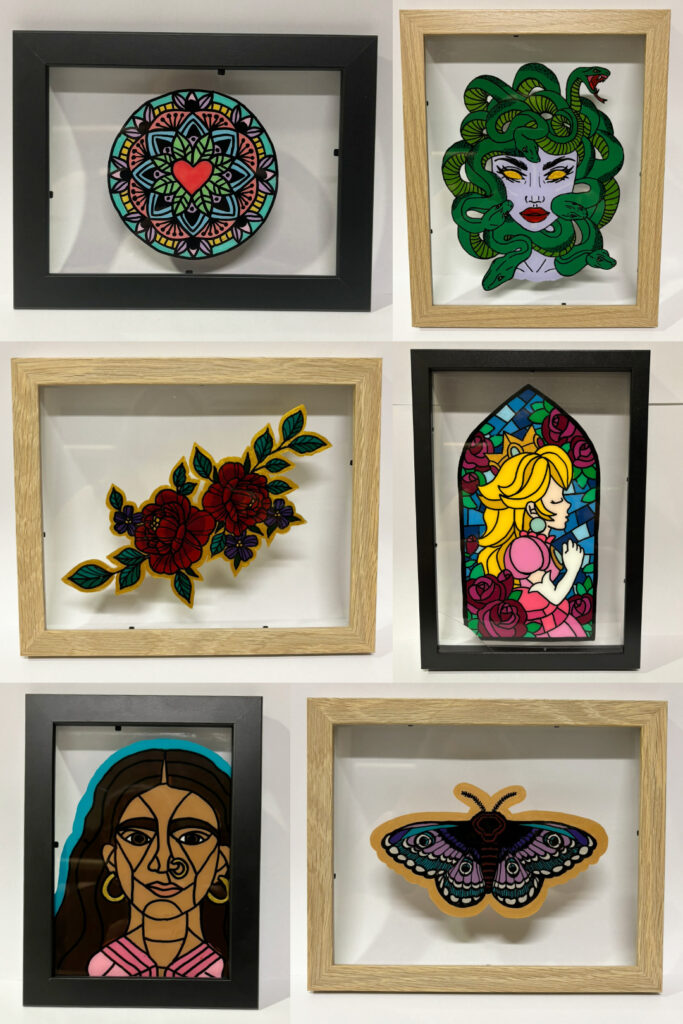
Acknowledgement of Country
For thousands of years the Kaurna people have walked on the land we meet today. We acknowledge them as the traditional owners and recognise them for their care and continued connection with this land. We acknowledge their Elders past, present and emerging and pay respect to Kaurna and other First Nations peoples present with us today. As a church community, we commit to actively work alongside First Nations people for truth, unity, equality, equity, and healing.
Timeline of the Night
6.30pm – Welcome and Art Warm Up
6.45pm – Extra Info and Theme Talk
6.55pm – Intro to Art Activity
7.00pm – Creative Time
From 7.00pm – Dinner
8.00pm – Dessert
8.45pm – Farewell
8.50pm – Pack Up


Art Warm Up
The art warm up is a simplified version of the main art activity. It’s purpose is to help you get you comfortable with being creative and help with some of the skills and techniques you might need later on.
You will need: a piece of clear acrylic, a stencil to trace, tape, oil based paint marker, acrylic paint markers.
Some of the set up has already been done.
The clear protective coating on one side has been removed and the stencil taped on.
For more details refer to instructions for main art activity further down the page.
Step 1: Use one of the black oil based markers to trace the design on your acrylic.
Make sure you shake the pen with it’s lid on before use.
The pens are quick drying, but be careful not to touch the line too soon or they will smudge.
Step 2: Remove the stencil and tape. Check your outline and make any adjustments if needed.
Step 3: Use the acrylic coloured paint markers to colour in the design.
You will need to do multiple coats, just make the base coat is dry first.
Step 4: Remove the protective plastic on the other side of the acrylic.

Theme for Reflection – The World is Complex
Each Create night we like to give you something to think about as you create. Art is a great medium to help us think about and process thoughts and concepts.
So we begin our nights with a short talk. Everyone will connect with it differently, some will connect it to their faith and others will connect it more with their life and the world around them.
I really encourage you to connect how you feel comfortable.
Let’s start with a question for you to think about, and talk to the people around you about.
Name some things that are opposites of each other.
We have this habit sometimes that we want to put things in our world into nice neat boxes.
To categorise them and sort them.
This here, and that there.
But as I am sure many of you know, the world is a bit more complex than that most of the time.
Things are not as simple as black or white, right or wrong, us or them.
We know it’s not just night or day. There is also dawn and dusk.
It’s not just summer or winter. There is autumn and spring.
People are not just male or female. There is a spectrum that includes people who are intersex, it includes gender expression.
The world is not just pain or joy, we are not just happy or sad. Most of the time it’s a bit of both and a bit of in between.
It’s not just whether I believe in God or I don’t. There are questions and doubts and uncertainty in all types of belief.
Let’s connect this back to our art activity tonight.
There isn’t just traditional art and modern art, it’s all impacted and inspired by each other.
Because tonight we are creating stained glass inspired art.
Stained glass has been around since at least the 7th century, so for almost 1500 years. So it would seem that we could call stained glass a traditional art form.
But the thing is, people are still creating stained glass. Some that look similar to those traditional forms and some that don’t. The techniques have changed and developed. And some people are even creating some with photo frames and textas.
It’s still all stained glass art.
And if we tried to define it as a traditional or modern art form, we really wouldn’t be doing justice to how broad and amazing the differing types of stained glass art are.
It’s the same in life, when we try so hard to fit things, or people in a category we miss the beauty in the diversity.
This thinking of, this or that, creates division between us and others. Thinking like you are with us or against us.
It’s an oversimplification of a world and people who are complexly diverse.
None of this means it’s easy to see beyond the black and white.
But hopefully we can learn to see that the world is more complex than we originally thought.
That when we see the complexity we can stop trying sorting things into firm categories, stop trying to fit the world into a neat box. Instead it can embrace the beauty in diversity and complexity.
This talk is to give you something to think about as you create and as you leave here tonight.
Maybe it will impact your art, or maybe it won’t. That’s ok.
But here at Create we do want to give you an opportunity to use art as a way to explore the world.
So as you create you might think of the lines between traditional and modern.
You might think about how your art sits in a place between being transparent and opaque.
You might think about a huge number of other things.
Stained Glass Inspired Artworks
Follow the links below for a video tutorial. The videos are all the same, just on different social media platforms.
CLICK HERE for tutorial on TIKTOK
CLICK HERE for tutorial on INSTAGRAM
CLICK HERE for tutorial on FACEBOOK
Or follow the instruction below.
What do you need: Photo frame, design to trace, tape, oil based paint marker, acrylic paint (or acrylic paint pens), paint brushes
How To:
Step 1: Take the glass or plastic out your frame. Make sure you remove any protective coatings.
Step 2: Tape your design to your glass.
Step 3: With the oil based marker trace the design.
Step 4: Peel of the design and check you lines. Make any adjustments you need.
Step 5: Colour in your image. Make sure you do this on the same side as you traced your outline.
Step 6: When you coloured your whole design, hold it up to light to see thin patches or areas you have missed.
Step 7: Go back and another another layer of paint. You may need 2 or more layers of paint.
Step 8: When dry, place glass back into your frame.


